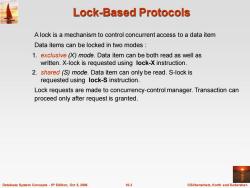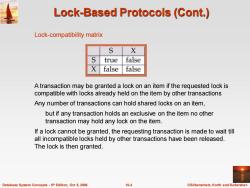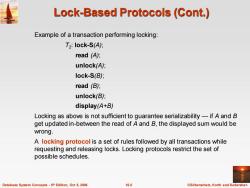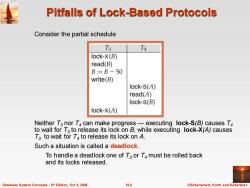《数据库系统概念 Database System Concepts》原书教学资源(第五版,PPT课件讲稿,英文版)Chapter 16 Concurrency Control

Chapter 16:Concurrency Control Lock-Based Protocols Timestamp-Based Protocols Validation-Based Protocols Multiple Granularity Multiversion Schemes Insert and Delete Operations Concurrency in Index Structures Database System Concepts-5th Edition,Oct 5,2006 16.2 @Silberschatz,Korth and Sudarshan
Database System Concepts - 5 16.2 ©Silberschatz, Korth and Sudarshan th Edition, Oct 5, 2006 Chapter 16: Concurrency Control Lock-Based Protocols Timestamp-Based Protocols Validation-Based Protocols Multiple Granularity Multiversion Schemes Insert and Delete Operations Concurrency in Index Structures

Lock-Based Protocols A lock is a mechanism to control concurrent access to a data item Data items can be locked in two modes: 1.exclusive (mode.Data item can be both read as well as written.X-lock is requested using lock-X instruction. 2.shared (S)mode.Data item can only be read.S-lock is requested using lock-S instruction. Lock requests are made to concurrency-control manager.Transaction can proceed only after request is granted. Database System Concepts-5th Edition,Oct 5,2006 16.3 ©Silberschat乜,Korth and Sudarshan
Database System Concepts - 5 16.3 ©Silberschatz, Korth and Sudarshan th Edition, Oct 5, 2006 Lock-Based Protocols A lock is a mechanism to control concurrent access to a data item Data items can be locked in two modes : 1. exclusive (X) mode. Data item can be both read as well as written. X-lock is requested using lock-X instruction. 2. shared (S) mode. Data item can only be read. S-lock is requested using lock-S instruction. Lock requests are made to concurrency-control manager. Transaction can proceed only after request is granted

Lock-Based Protocols (Cont.) Lock-compatibility matrix S X S true false X false false Atransaction may be granted a lock on an item if the requested lock is compatible with locks already held on the item by other transactions Any number of transactions can hold shared locks on an item, but if any transaction holds an exclusive on the item no other transaction may hold any lock on the item. If a lock cannot be granted,the requesting transaction is made to wait till all incompatible locks held by other transactions have been released. The lock is then granted. Database System Concepts-5th Edition,Oct 5,2006 16.4 @Silberschatz,Korth and Sudarshan
Database System Concepts - 5 16.4 ©Silberschatz, Korth and Sudarshan th Edition, Oct 5, 2006 Lock-Based Protocols (Cont.) Lock-compatibility matrix A transaction may be granted a lock on an item if the requested lock is compatible with locks already held on the item by other transactions Any number of transactions can hold shared locks on an item, but if any transaction holds an exclusive on the item no other transaction may hold any lock on the item. If a lock cannot be granted, the requesting transaction is made to wait till all incompatible locks held by other transactions have been released. The lock is then granted

Lock-Based Protocols (Cont.) Example of a transaction performing locking: T2:lock-S(A); read (A); unlock(A); lock-S(B); read (B); unlock(B); display(A+B) Locking as above is not sufficient to guarantee serializability-if A and B get updated in-between the read of A and B,the displayed sum would be wrong. A locking protocol is a set of rules followed by all transactions while requesting and releasing locks.Locking protocols restrict the set of possible schedules. Database System Concepts-5th Edition,Oct 5,2006 16.5 ©Silberschat乜,Korth and Sudarshan
Database System Concepts - 5 16.5 ©Silberschatz, Korth and Sudarshan th Edition, Oct 5, 2006 Lock-Based Protocols (Cont.) Example of a transaction performing locking: T2 : lock-S(A); read (A); unlock(A); lock-S(B); read (B); unlock(B); display(A+B) Locking as above is not sufficient to guarantee serializability — if A and B get updated in-between the read of A and B, the displayed sum would be wrong. A locking protocol is a set of rules followed by all transactions while requesting and releasing locks. Locking protocols restrict the set of possible schedules

Pitfalls of Lock-Based Protocols Consider the partial schedule T3 Ta lock-X(B) read(B) B:=B-50 write(B) lock-S(A) read(A) lock-S(B) lock-X(A) Neither T3 nor T4 can make progress-executing lock-S(B)causes T4 to wait for T3 to release its lock on B,while executing lock-X(A)causes T3 to wait for T4 to release its lock on A. Such a situation is called a deadlock. To handle a deadlock one of Ta or T4 must be rolled back and its locks released. Database System Concepts-5th Edition,Oct 5,2006 16.6 ©Silberschat乜,Korth and Sudarshan
Database System Concepts - 5 16.6 ©Silberschatz, Korth and Sudarshan th Edition, Oct 5, 2006 Pitfalls of Lock-Based Protocols Consider the partial schedule Neither T3 nor T4 can make progress — executing lock-S(B) causes T4 to wait for T3 to release its lock on B, while executing lock-X(A) causes T3 to wait for T4 to release its lock on A. Such a situation is called a deadlock. To handle a deadlock one of T3 or T4 must be rolled back and its locks released

Pitfalls of Lock-Based Protocols (Cont.) The potential for deadlock exists in most locking protocols.Deadlocks are a necessary evil. Starvation is also possible if concurrency control manager is badly designed.For example: A transaction may be waiting for an X-lock on an item,while a sequence of other transactions request and are granted an S-lock on the same item. The same transaction is repeatedly rolled back due to deadlocks. Concurrency control manager can be designed to prevent starvation. Database System Concepts-5th Edition,Oct 5,2006 16.7 @Silberschatz,Korth and Sudarshan
Database System Concepts - 5 16.7 ©Silberschatz, Korth and Sudarshan th Edition, Oct 5, 2006 Pitfalls of Lock-Based Protocols (Cont.) The potential for deadlock exists in most locking protocols. Deadlocks are a necessary evil. Starvation is also possible if concurrency control manager is badly designed. For example: A transaction may be waiting for an X-lock on an item, while a sequence of other transactions request and are granted an S-lock on the same item. The same transaction is repeatedly rolled back due to deadlocks. Concurrency control manager can be designed to prevent starvation

The Two-Phase Locking Protocol This is a protocol which ensures conflict-serializable schedules. Phase 1:Growing Phase transaction may obtain locks transaction may not release locks Phase 2:Shrinking Phase transaction may release locks transaction may not obtain locks The protocol assures serializability.It can be proved that the transactions can be serialized in the order of their lock points (i.e. the point where a transaction acquired its final lock). Database System Concepts-5th Edition,Oct 5,2006 16.8 ©Silberschat乜,Korth and Sudarshan
Database System Concepts - 5 16.8 ©Silberschatz, Korth and Sudarshan th Edition, Oct 5, 2006 The Two-Phase Locking Protocol This is a protocol which ensures conflict-serializable schedules. Phase 1: Growing Phase transaction may obtain locks transaction may not release locks Phase 2: Shrinking Phase transaction may release locks transaction may not obtain locks The protocol assures serializability. It can be proved that the transactions can be serialized in the order of their lock points (i.e. the point where a transaction acquired its final lock)

The Two-Phase Locking Protocol (Cont.) Two-phase locking does not ensure freedom from deadlocks Cascading roll-back is possible under two-phase locking.To avoid this, follow a modified protocol called strict two-phase locking.Here a transaction must hold all its exclusive locks till it commits/aborts. Rigorous two-phase locking is even stricter:here all locks are held till commit/abort.In this protocol transactions can be serialized in the order in which they commit. Database System Concepts-5th Edition,Oct 5,2006 16.9 ©Silberschat乜,Korth and Sudarshan
Database System Concepts - 5 16.9 ©Silberschatz, Korth and Sudarshan th Edition, Oct 5, 2006 The Two-Phase Locking Protocol (Cont.) Two-phase locking does not ensure freedom from deadlocks Cascading roll-back is possible under two-phase locking. To avoid this, follow a modified protocol called strict two-phase locking. Here a transaction must hold all its exclusive locks till it commits/aborts. Rigorous two-phase locking is even stricter: here all locks are held till commit/abort. In this protocol transactions can be serialized in the order in which they commit

The Two-Phase Locking Protocol (Cont.) There can be conflict serializable schedules that cannot be obtained if two-phase locking is used. However,in the absence of extra information(e.g.,ordering of access to data),two-phase locking is needed for conflict serializability in the following sense: Given a transaction T that does not follow two-phase locking,we can find a transaction T that uses two-phase locking,and a schedule for T; and T that is not conflict serializable. Database System Concepts-5th Edition,Oct 5,2006 16.10 ©Silberschat乜,Korth and Sudarshan
Database System Concepts - 5 16.10 ©Silberschatz, Korth and Sudarshan th Edition, Oct 5, 2006 The Two-Phase Locking Protocol (Cont.) There can be conflict serializable schedules that cannot be obtained if two-phase locking is used. However, in the absence of extra information (e.g., ordering of access to data), two-phase locking is needed for conflict serializability in the following sense: Given a transaction Ti that does not follow two-phase locking, we can find a transaction Tj that uses two-phase locking, and a schedule for Ti and Tj that is not conflict serializable

Lock Conversions Two-phase locking with lock conversions: First Phase: can acquire a lock-S on item can acquire a lock-X on item can convert a lock-S to a lock-X(upgrade) Second Phase: can release a lock-S can release a lock-X can convert a lock-X to a lock-S (downgrade) This protocol assures serializability.But still relies on the programmer to insert the various locking instructions. Database System Concepts-5th Edition,Oct 5,2006 16.11 ©Silberschat乜,Korth and Sudarshan
Database System Concepts - 5 16.11 ©Silberschatz, Korth and Sudarshan th Edition, Oct 5, 2006 Lock Conversions Two-phase locking with lock conversions: – First Phase: can acquire a lock-S on item can acquire a lock-X on item can convert a lock-S to a lock-X (upgrade) – Second Phase: can release a lock-S can release a lock-X can convert a lock-X to a lock-S (downgrade) This protocol assures serializability. But still relies on the programmer to insert the various locking instructions
按次数下载不扣除下载券;
注册用户24小时内重复下载只扣除一次;
顺序:VIP每日次数-->可用次数-->下载券;
- 《数据库系统概念 Database System Concepts》原书教学资源(第五版,PPT课件讲稿,英文版)Chapter 15 Transactions.ppt
- 《数据库系统概念 Database System Concepts》原书教学资源(第五版,PPT课件讲稿,英文版)Chapter 14 Query Optimization.ppt
- 《数据库系统概念 Database System Concepts》原书教学资源(第五版,PPT课件讲稿,英文版)Chapter 13 Query Processing.ppt
- 《数据库系统概念 Database System Concepts》原书教学资源(第五版,PPT课件讲稿,英文版)Chapter 12 Indexing and Hashing.ppt
- 《数据库系统概念 Database System Concepts》原书教学资源(第五版,PPT课件讲稿,英文版)Chapter 11 Storage and File Structure.ppt
- 《数据库系统概念 Database System Concepts》原书教学资源(第五版,PPT课件讲稿,英文版)Chapter 10 XML.ppt
- 《数据库系统概念 Database System Concepts》原书教学资源(第五版,PPT课件讲稿,英文版)Chapter 1 Introduction(Avi Silberschatz Henry F. Korth S. Sudarshan).ppt
- 《数据库系统概念 Database System Concepts》原书教学资源(第五版,附录,英文版)Appendix C Advanced Relational Database Design.ppt
- 《数据库系统概念 Database System Concepts》原书教学资源(第五版,附录,英文版)Chapter B Hierarchical Model.ppt
- 《数据库系统概念 Database System Concepts》原书教学资源(第五版,附录,英文版)Chapter A Network Model.ppt
- 《数据库系统概念 Database System Concepts》原书教学资源(第六版,附录,英文版)Hierarchical Model.pdf
- 《数据库系统概念 Database System Concepts》原书教学资源(第六版,附录,英文版)Network Model.pdf
- 《数据库系统概念 Database System Concepts》原书教学资源(第六版,附录,英文版)Other Relational Query Languages.pdf
- 《数据库系统概念 Database System Concepts》原书教学资源(第六版,附录,英文版)Advanced Relational Database Design.pdf
- 《数据库系统概念 Database System Concepts》原书教学资源(第六版,PPT课件讲稿,英文版)Chapter 9 Application Design and Development.ppt
- 《数据库系统概念 Database System Concepts》原书教学资源(第六版,PPT课件讲稿,英文版)Chapter 8 Relational Database Design.ppt
- 《数据库系统概念 Database System Concepts》原书教学资源(第六版,PPT课件讲稿,英文版)Chapter 7 Database Design - The Entity-Relationship Approach.ppt
- 《数据库系统概念 Database System Concepts》原书教学资源(第六版,PPT课件讲稿,英文版)Chapter 6 Formal Relational Query Languages.ppt
- 《数据库系统概念 Database System Concepts》原书教学资源(第六版,PPT课件讲稿,英文版)Chapter 5 Advanced SQL.ppt
- 《数据库系统概念 Database System Concepts》原书教学资源(第六版,PPT课件讲稿,英文版)Chapter 4 Intermediate SQL.ppt
- 《数据库系统概念 Database System Concepts》原书教学资源(第五版,PPT课件讲稿,英文版)Chapter 17 Recovery System.ppt
- 《数据库系统概念 Database System Concepts》原书教学资源(第五版,PPT课件讲稿,英文版)Chapter 18 Data Analysis and Mining.ppt
- 《数据库系统概念 Database System Concepts》原书教学资源(第五版,PPT课件讲稿,英文版)Chapter 19 Information Retrieval.ppt
- 《数据库系统概念 Database System Concepts》原书教学资源(第五版,PPT课件讲稿,英文版)Chapter 2 Relational Model.ppt
- 《数据库系统概念 Database System Concepts》原书教学资源(第五版,PPT课件讲稿,英文版)Chapter 20 Database System Architectures.ppt
- 《数据库系统概念 Database System Concepts》原书教学资源(第五版,PPT课件讲稿,英文版)Chapter 21 Parallel Databases.ppt
- 《数据库系统概念 Database System Concepts》原书教学资源(第五版,PPT课件讲稿,英文版)Chapter 22 Distributed Databases.ppt
- 《数据库系统概念 Database System Concepts》原书教学资源(第五版,PPT课件讲稿,英文版)Chapter 23 Advanced Application Development.ppt
- 《数据库系统概念 Database System Concepts》原书教学资源(第五版,PPT课件讲稿,英文版)Chapter 24 Advanced Data Types.ppt
- 《数据库系统概念 Database System Concepts》原书教学资源(第五版,PPT课件讲稿,英文版)Chapter Advanced Transaction Processing.ppt
- 《数据库系统概念 Database System Concepts》原书教学资源(第五版,PPT课件讲稿,英文版)Chapter 3 SQL.ppt
- 《数据库系统概念 Database System Concepts》原书教学资源(第五版,PPT课件讲稿,英文版)Chapter 4 Advanced SQL.ppt
- 《数据库系统概念 Database System Concepts》原书教学资源(第五版,PPT课件讲稿,英文版)Chapter 5 Other Relational Languages.ppt
- 《数据库系统概念 Database System Concepts》原书教学资源(第五版,PPT课件讲稿,英文版)Chapter 6 Entity-Relationship Model.ppt
- 《数据库系统概念 Database System Concepts》原书教学资源(第五版,PPT课件讲稿,英文版)Chapter 7 Relational Database Design.ppt
- 《数据库系统概念 Database System Concepts》原书教学资源(第五版,PPT课件讲稿,英文版)Chapter 8 Application Design and Development.ppt
- 《数据库系统概念 Database System Concepts》原书教学资源(第五版,PPT课件讲稿,英文版)Chapter 9 Object-Based Databases.ppt
- 《数据库系统概念 Database System Concepts》原书教学资源(第七版,PPT课件讲稿,英文版)Chapter 01 Introduction(Avi Silberschatz Henry F. Korth S. Sudarshan).pptx
- 《数据库系统概念 Database System Concepts》原书教学资源(第七版,PPT课件讲稿,英文版)Chapter 10 Big Data.pptx
- 《数据库系统概念 Database System Concepts》原书教学资源(第七版,PPT课件讲稿,英文版)Chapter 11 Data Analytics.pptx
